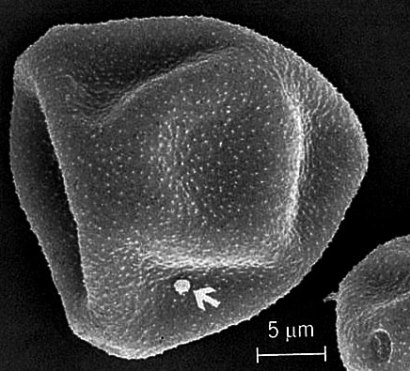Tiny granules found within the pollen sacs of numerous species of flowers may play a key role in allergic reactions associated with pollen. Measuring less than 4 micrometers (μm) in diameter (most being less than 1 μm), these granules are called orbicules, or Ubisch bodies, and they are composed of sporopollenin (a durable biopolymer found in spores and pollen grains) and produced within tapetum cells (which provide a layer of nutritive cells for pollen grain development). The orbicules are sometimes positioned in close contact with pollen grains and can be dispersed into the atmosphere when pollen is released from the anthers of flowers (note that each anther contains four pollen sacs, or microsporangia, in which pollen are produced). Although researchers have been puzzled by these structures, orbicules may act as allergens (that is, substances foreign to the body that cause allergy) and could be the critical factor for why pollen causes allergic reactions. See also: Allergy; Flower; Palynology; Plant organs; Pollen; Population dispersal

In general, pollen grains are too large in size to reach the smallest regions of the human lungs; thus, there must be another, smaller agent (measuring only a few micrometers or less) that is directly responsible for the allergenic activity. It has been postulated that orbicules are indeed the small particles that act as efficient vectors, bringing allergens to susceptible individuals. For example, studies of many allergy-inducing plants, including hazel (Corylus), birch (Betula), Japanese cedar (Cryptomeria japonica), and numerous grass species, indicate that the substances responsible for the allergic reactions are found within the orbicules. Moreover, due to the extremely small size of orbicules, they may remain in the air long after the pollen season has ended, thereby affecting susceptible individuals (especially bronchial asthma sufferers) throughout the year. This also implies that typical pollen counts are inaccurate as a measure of outdoor allergen activity, particularly if orbicules are the true sources and, thus, indicators of allergenic activity. Still, because of their miniscule size, orbicules are challenging to study. In addition, many species of allergenic plants do not contain orbicules associated with their pollen grains, and some researchers believe that this indicates that orbicules are simple by-products of the tapetum cells or remnants of a primitive feature of ancient seed plants. Therefore, more investigations are necessary to demonstrate firmer connections between orbicules and the clinical symptoms of allergies and other related immunologic reactions. See also: Asthma; Birch; Immunology; Lung





